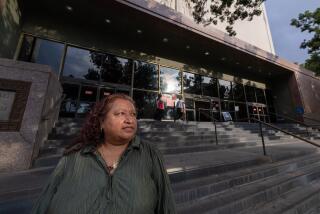Lawyers Lend a Free Hand to Abused
They each wait patiently in line to tell their story of horror and abuse.
In a hushed but calm voice, a bank employee from Echo Park tells how her ex-husband, knife in hand, forced her to have sex with him, hit her in the eye with his fist and then made her withdraw money from a bank cash machine before he would leave.
Ten minutes later, a 63-year-old Los Angeles woman explains that her son, 40, struck her across the face because she criticized his girlfriend. Heâs an alcoholic, she says, and âdidnât know what he was doing.â
The Line Forms
The line forms in Department 8 of the downtown courthouse, where Commissioner Robert A. Schnider decides whether to issue restraining orders against the alleged abusers.
But the women--for nearly everyone in line is a woman, and many are elderly--are not waiting to see the commissioner, who acts as a judge in these cases. They are waiting to tell their story to volunteer lawyers of the Domestic Violence Project, sponsored by the Los Angeles County Bar young lawyers division.
These lawyers will not actually represent the women and few men waiting in line; they give free advice at a desk in the courtroom to anyone who walks in the door.
On a first-come, first-served basis, the lawyers help their ad hoc clients fill out the proper legal forms to make their case, so they can get the relief they need--usually a court order telling their husbands, boyfriends, parents or children to get out of the house and stay away.
The attorneys will assist anyone in line, regardless of income, and sometimes they help those who are accused as well as the accusers.
If a battered woman can persuade the judge that she is in danger of âgreat or irreparable injury,â she may have a temporary restraining order that very day. It is a powerful remedy and it is exercised with judicial caution.
âWe get people kicked out of their homes in 20 minutes, so we have to do things in a careful manner,â says Madeleine Bryant-Kambe, the attorney-administrator of the volunteer project.
The Domestic Violence Act was passed to give battered wives and others a judicial remedy to stop the violence. Although the forms were designed to be used by lay people, without lawyers, they can easily be misunderstood if one has no legal advice.
Before a court will issue a restraining order, the paper work has to be in order. The proper declarations must be made in writing under penalty of perjury. How many times did he hit you? When was the most recent time he hit you? Did he threaten you? The lawyers look for the specifics that will persuade a judge that a restraining order is necessary.
Vague Threats
It is not enough to complain of vague threats or possible violence; recent and severe violence must be described in convincing detail.
And it is, every day. Schnider estimates that 80% of the 15 or so cases he hears each day have âsignificant levels of violence.â Asked to give examples of such violence, he ticked off recent examples: kicking in the ribs, beating with belts, throwing objects, burning the breast and arms with an iron.
But he stressed that he must be careful. For a low-income person, he may be sentencing homelessness.
Under state law, he can issue restraining orders without even giving the other party a chance to be heard. They are only in effect for a few weeks and then a full hearing is held to determine whether to continue them for a year. Also, you can mount a legal challenge to the order within days, but by that time the police may have already removed you from your home and ordered you to stay away from your children and spouse.
When the other side of the story isnât heard, someone who lies can abuse the system, Schnider said. He told of one case where a woman persuaded him that her husband was violent. Then she used the restraining order to run away with her children to Tennessee. The husband, Schnider said, actually deserved custody.
A Police Road Map
The great benefit of a restraining order is that âit provides the police a road map as to how to proceed,â said Bryant-Kambe. In family disputes, a call most police officers abhor, the policeman or policewoman often does not know who is to blame or whom to believe. With a restraining order in hand, Schnider explained, âcops donât have to make a spot decision requiring the skills of a Viennese analystâ and âthey are happy to enforce the order.â
The project lawyers do not assist in neighborhood disputes, employment matters or landlord-tenant problems. But they do offer help to family members, including parents and grandparents, people living together, parents of a common child and lovers who are experiencing violence or threats of violence.
They may be able to help you seek an order to keep someone a certain distance away from you, grant temporary custody of children or order someone out of your house. The project does not operate every day, and the hours are expected to change this month. Information: (213) 624-3665.
Attorney Jeffrey S. Klein, The Timesâ senior staff counsel, cannot answer mail personally but will respond in this column to questions of general interest about the law. Do not telephone. Write to Jeffrey S. Klein, Legal View, The Times, Times Mirror Square, Los Angeles 90053.
More to Read
Sign up for Essential California
The most important California stories and recommendations in your inbox every morning.
You may occasionally receive promotional content from the Los Angeles Times.










